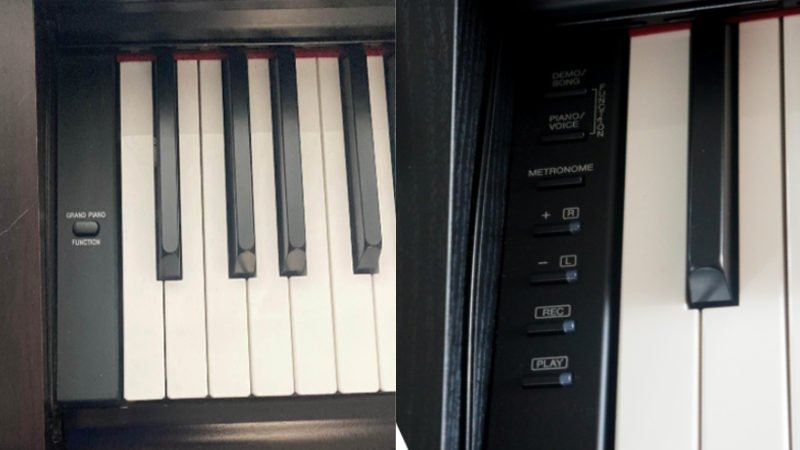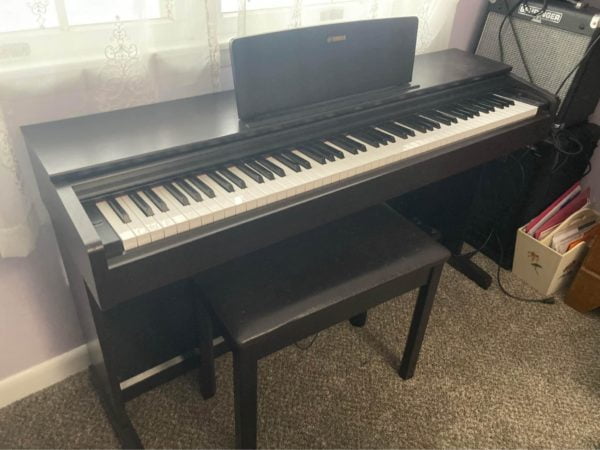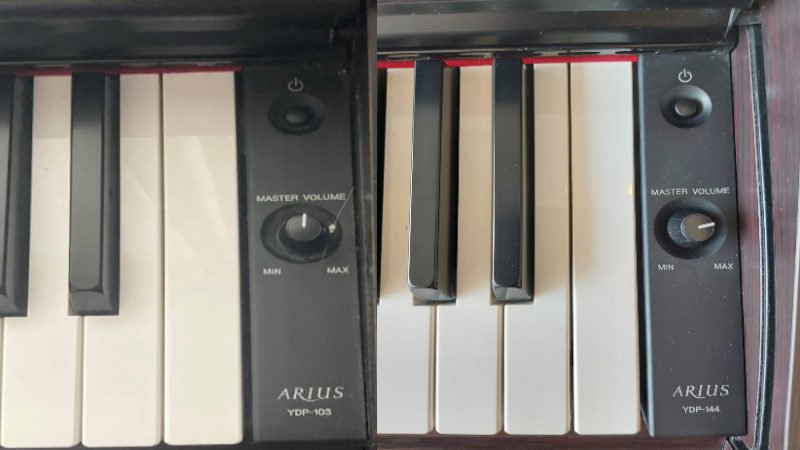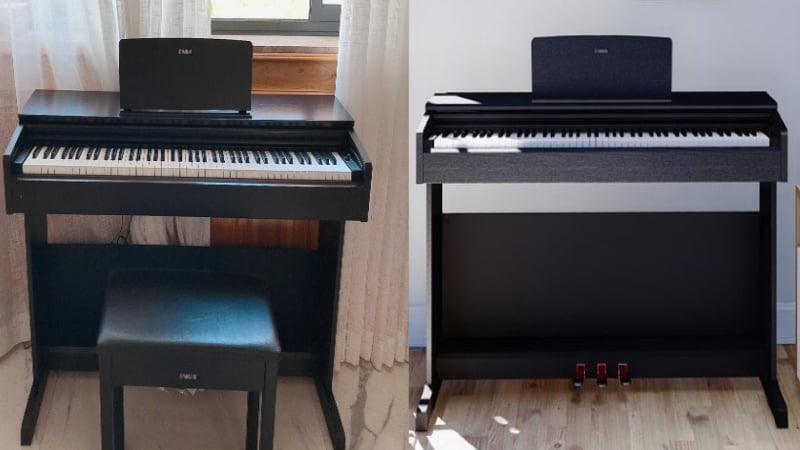Find out which Yamaha Arius model is the best option in this Yamaha YDP-103 vs 144 reviews.
In the world of console digital pianos, the Yamaha Arius collection is by far one of my favorites. This product line contains top-quality digital pianos that are relatively affordable. And two particular pianos that stand out are the Yamaha YDP-103 and the Yamaha YDP-144.
That’s why I decided to create this Yamaha YDP-103 vs 144 review. The YDP-144 is the more expensive model, and with that came a bunch of additional features.
To be honest, the differences between these two pianos are few and far between. While the YDP-144 does come with more features, it is a bit more expensive, and these features may not exactly be that necessary for beginners.
With that said, I found that the Yamaha YDP-144 won out at the end of the day, but only by a little bit. Keep reading to find out how the budget-friendly YDP-103 held up against the more expensive YDP-144.
Yamaha YDP-103 vs 144: Comparison Chart




Last update on 2025-06-30 / Affiliate links / Images from Amazon Product Advertising API
Yamaha YDP-103 vs 144: The Features
To figure out the winner in this comparison, I decided to compare the features. And to my surprise, the Yamaha YDP-103 was tied in almost every aspect of the comparison. But at the end of the day, the Yamaha YDP-144 does have a significantly better tone, which is why it won out with a final score of 3-2.
Tone
The winner: Yamaha YDP-144
If you give both of these pianos a spin, you’ll find that they have an almost identical sound library. However, when testing them out, I found that the Yamaha YDP-144’s tone generator was superior to the YDP-103, which is why the YDP-144 won the point in this category.
+Tone Generation
Both of these pianos use samples to generate tones. However, the exact tone engines they use are a bit different. The Yamaha YDP-103 uses the AWM Stereo Sampling method. This method contains multi-layered samples designed to replicate the sound of real acoustic instruments.
When crafting this piano, Yamaha made sure to load it with additional memory. That way, the piano can handle more detailed samples that will beat out a lot of other options in this price range.
However, while the AWM Sampling method produces great tones, it can’t compare to Yamaha’s CFX Sampling, which you can find on the YDP-144. The piano tones on this instrument come directly from the Yamaha CF concert grand pianos, some of the most coveted models on the market.
So, when it comes to realistic piano tones, the YDP-144 is the better option. But if you’re a beginner or novice piano player, the YDP-103 can still produce great piano tones that exceed the expectations of its price range.

+Sound Library
When it comes to the sound library, both of these pianos are identical. With digital console pianos, the focus is on quality over quantity. So, you won’t be able to find as wide of a voice range as you can with a digital keyboard.
With that said, both pianos come with a 10-voice sound library. The sound library covers all the essential tones you’ll need as a pianist. This includes a variety of acoustic piano and electric piano voices, some strings voices, and even bass voices for when you’re playing with a band.
Both of these pianos offer a fair amount of versatility. But since the Yamaha YDP-144 is the more expensive option, it would have been nice for it to include a wider sound library.
Feel & Playability
The winner: Tie
Both of these pianos feature the same hammer action system and the same type of keys. Because of this, they feel identical. So, when comparing the feel of both pianos, I couldn’t pick a winner between the two.
+Hammer Action
Both of these pianos use the Yamaha Graded Hammer Standard. In this price range, you won’t find a much better hammer action system. While other brands try to get the same weight as an acoustic piano, none of them really do it as well as Yamaha with their GHS system.
This Hammer Action system is specifically designed to replicate the feel of an acoustic piano. So, that means the lower keys will be significantly heavier than the higher keys. This results in a very realistic feel, making it ideal for people who are used to acoustic pianos.
On top of that, if you’re a beginner, practicing on a digital piano with realistic hammer action is essential. That way, you won’t have to worry about having to make major adjustments to your playing style when you move to acoustic pianos.
With that said, it would have been nice if the YDP-144 featured the Graded Hammer 3 (GH3). This is Yamaha’s most sophisticated hammer action system, able to deliver a more realistic springback that you’d expect from premium pianos.
So, in terms of value of the money, you might be getting a better bang for your buck with the Yamaha YDP-103.

+Key Texture
When it came down to the key texture of the pianos, I could barely tell them apart. This is because they have a subtle coating designed to replicate the feel of real ebony and ivory keys. This is a great feature, since most digital pianos usually just have either plastic or wooden keys.
Wooden keys are by far the best option, but considering how much they add to the piano’s price and maintenance, you might be better off with plastic keys. Both of these pianos feature plastic keys with a textured coating. While they do feel more realistic than glossy plastic keys, they still don’t feel identical to wooden keys.
Piano Features
The winner: Tie
Another area where these two pianos were tied are the piano features. Both models feature the same playing modes and effects. This is kind of a let-down considering the YDP-144 is the more expensive model, but all of these extra features are incredibly useful nonetheless.
+Playing Modes
Both of these pianos come with lesson mode and dual mode. With lesson mode, you can divide the piano into two mini-keyboards. That way, the teacher and student can play along together without having to cross over to the other side. And with dual mode, you can blend two different voices together to produce a unique voice that you can customize.
These are some of the most useful playing modes that any pianist would greatly enjoy. But since the Yamaha YDP-144 is the more expensive model, it comes with one additional playing mode. This is split mode, which allows you to load two different voices at the same time.
This is a great feature for experienced and performing pianists as it can give off the illusion that you’re playing two instruments at a time.
+Effects
In terms of effects, both of these pianos are largely lacking in my opinion. In this price range, you can usually find reverb, chorus, DSP, and even brilliance effects. However, with these Yamaha pianos, all you get is reverb.
Granted, if you’re a beginner or even an experienced pianist, reverb is the only effect that’s absolutely essential in getting a rich tone. However, it still would have been nice if these pianos offered a bit more versatility.
Yamaha YDP-103 vs 144: The Similarities

These pianos come from the same brand and product line. Naturally, they will share a fair amount of similarities. We’ve already mentioned that these pianos share the same hammer action system and key texture. That means if all you need is a realistic feel, you might be better off saving some money with the YDP-103.
Additionally, both pianos have the same sound library. While the YDP-144 definitely has richer and more realistic tones, the types of voices on both pianos are about the same. These similarities go all the way down to the types of effects on the piano.
At the end of the day, the Yamaha YDP-144 won out, but only by a very slight margin. So, if you’re shopping on a budget, then the Yamaha YDP-103 can serve you just as well, the only catch is the tones won’t be as rich.
Quick Rundown of the Yamaha YDP-103
- Your purchase includes One Yamaha Arius Series, YDP103 model | Bench, Owner’s manual & Quick Operation Guide
- Piano dimensions – 53-7/16” W x 32-1/16” H x 16-5/8” | Weight – 82 lbs. | Number of pedals – 3 | Max polyphony – 64 | Number of voices – 10 | Headphones – (2) Standard Stereo phone jack | No recording nor playback capabilities
- GHS weighted action is heavier in the low keys and lighter in the high keys, just like an acoustic piano
- The special matte black key tops are designed to absorb moisture and remain tactile after extended use without becoming slippery
- The controller app for iOS devices adds a rich graphical user interface, allowing for quick and easy navigation and configuration
Last update on 2025-06-30 / Affiliate links / Images from Amazon Product Advertising API
Quick Rundown of the Yamaha YDP-144
- Your purchase includes One Yamaha Arius Series, YDP144 model | Bench, 50 Classical Music Masterpieces Book, Owner’s manual & Quick Operation Guide
- Piano dimensions – 53-7/16” W x 32-1/16” H x 16-5/8” | Weight – 83 lbs. | Number of pedals – 3 | Max polyphony – 192 | Number of voices – 10 | Headphones – (2) Standard Stereo phone jack | With Recording and Playback capabilities
- GHS weighted action is heavier in the low keys and lighter in the high keys, just like an acoustic piano
- Half-damper pedal control allows for continuously increasing amounts of sustain as the pedal is depressed
- The CFX Premium Grand Piano Voice recreates the power and tone of the flagship CFX concert grand piano from Yamaha
Last update on 2025-06-30 / Affiliate links / Images from Amazon Product Advertising API
Product Videos
Related Articles to Yamaha Ydp 103
Related Articles to Yamaha Ydp 144
- Yamaha YDP144 vs YDP-144R: What’s the Difference?
- Yamaha YDP-144 vs YDP-S54: What’s the Difference?
- Yamaha YDP-144 vs 184: Which Is the Best Arius Model for the Money?
- Yamaha YDP-144 vs YDP-181: Is the YDP-144 a Worthy Upgrade?
- Yamaha YDP-144 vs Roland F-140R: Which Digital Piano Do You Need?
- Yamaha YDP-144 vs Kawai KDP-120: Which Piano Is the Best?
- Yamaha YDP-144 vs Kawai KDP-110: Why the YDP-144 Is the Better Piano
- Yamaha YDP-144 vs 164: Which Is the Better Arius Piano?
- Yamaha DGX-660 vs YDP-144: Which Is the Better Yamaha Piano?
- Yamaha DGX-670 vs YDP 144: Finding the Best Digital Piano
- Yamaha YDP144 vs 163: Which Is The Best Arius?
- Yamaha YDP144 vs S34: Which Suits Your Style Better?
- Yamaha YDP-143 Vs 144: Is The YDP-144 A Worthy Upgrade?
- Casio PX-870 Vs Yamaha YDP-144: Which Is The Better Console Digital Piano?
- Casio PX-770 vs Yamaha YDP-144: Which Is The Better Digital Piano?
References:
- Yamaha YDP-103: https://www.pianodreamers.com/yamaha-ydp103-review/
- Yamaha YDP-144: https://www.pianodreamers.com/yamaha-ydp144-review/
Lulacruza is an electronic folk duo operating at the junction of the hypermodern and the ancient. Our music weaves together hypnotic female singing, South American folk instruments and electronic processing, while channeling pulsating waves from the source of creation.
Lalucruza is also a community where you can connect with other music lovers to collaborate, exchange ideas and share knowledge. A platform for who wants to learns the basics of playing piano, guitar, drum masters’ technique, etc.. is the premise of our website.
